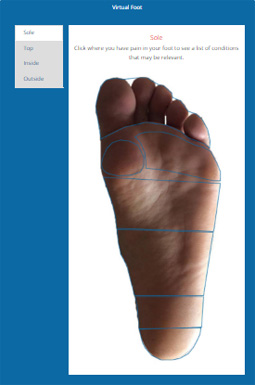Choosing Running Shoes
Choosing running shoes can be a confusing task. We now have a greater choice than ever: minimalist, maximalist, neutral, stability, motion control, cushioned, barefoot…where do you start?
Generally, we are told that the foot can be categorised into 3 main foot types: Pronated (low arch), neutral (normal) and supinated (high arch). Runners have been advised to do the ‘wet foot print test’ (figure 1) and pick the corresponding shoe to their foot type: motion control shoe for a pronated foot, neutral for a normal foot and cushion for high arch. Simple and easy to understand, right? Unfortunately, it is too simple!

Figure 1. Wet foot print test
What the research shows us is that there is no association between static measurements (wet foot print test) and dynamic function (the way your foot works when running). Therefore we can conclude that foot shape is not predictive of dynamic function and that you should not use the ‘wet foot print test’ to pick your running shoe.
Categorising foot function into 3 groups is overly simplistic; we must approach this with a much more person specific way. Now let me be clear, I’m not saying that the shoes aren’t doing what they say they are doing but we just don’t have a really reliable method of matching a shoe to a particular foot type. So, until we have a better method to match shoes to foot types, I believe that Comfort should be the overriding factor when choosing and buying a running shoe (and there is evidence to show that this will reduce frequency of injury).
So what are the factors that would influence how comfortable a shoe is? The first thing to consider may be the ‘drop’ or heel height differential of a shoe. This is defined as the height difference of the midsole material underneath the heel, and underneath the ball of the foot. Traditionally this ‘drop’ has been 10-12mm, whilst for minimalist footwear it is anywhere between 0-4mm. What the research tells us is that for some runners, a more minimalistic shoe will be beneficial, whilst for others; a more traditional shoe with a higher drop will be beneficial. There is not one rule for all; it is very much a case of horses for courses.
Another consideration is stack height. This is the height of the heel and forefoot in the shoe. In basic terms the higher the stack the more material under the foot and therefore cushioning the shoe will have. A good example of a shoe with a high stack is the Hoka range which seem to have a bit of a cult following, especially amongst the ultra runners. The more minimalist shoes tend to have a lower stack height as well as a lower drop. Again not one stack height will suit everyone; some may prefer a more cushioned shoe while others may prefer a lighter, less cushioned and more responsive shoe.
Last but certainly not least, is the width of a shoe. All shoes are manufactured around a last; some manufacturers use a wider last, some a narrower last. If you have a very wide foot, you certainly don’t want to be running in a shoe with a narrow toe box and vice versa.
So to summarise, despite what you have read or heard, there is not one shoe, or type of shoe, that will make you run faster, run better, run with a certain type of foot strike or reduce your chance of injury. Shoe selection must be made, very much, on a person-to-person basis. There is a degree of trial and error when choosing your running shoe but when you find a shoe that is right for you DON’T CHANGE.



